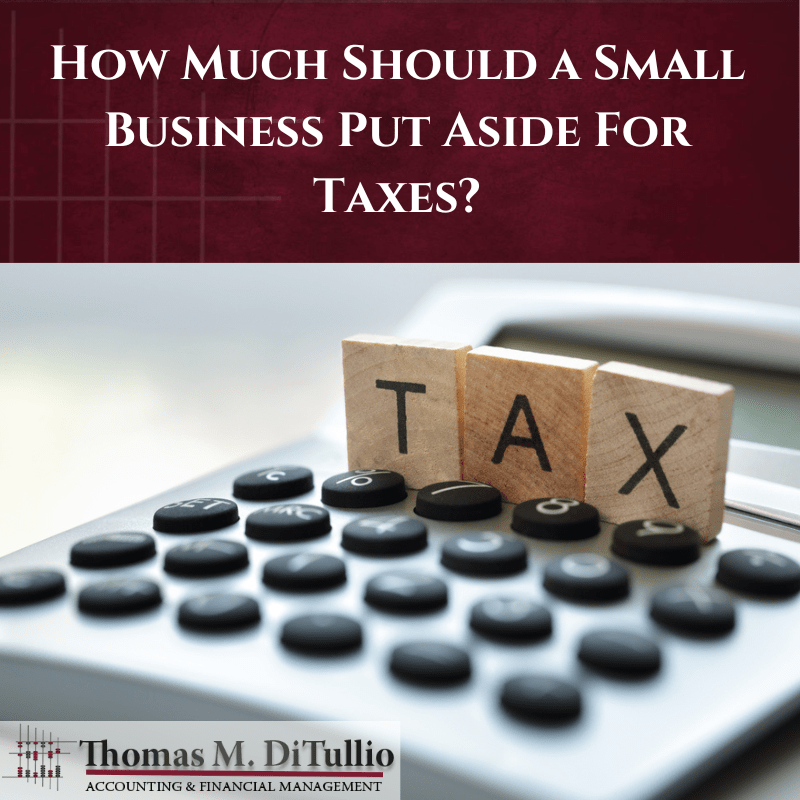How Much Should a Small Business Set Aside for Taxes?
There is no question that every small business owner dreads the arrival of tax season. Between gathering all the information you will need to complete your taxes, finding all the forms necessary and then completing all those forms, it can be frustrating, time-consuming and stressful. Add to that the possibility you could have to write a hefty check to the government, and it is easy to see why businesses may not look forward to filing taxes. TMD Accounting offers these tips to help you avoid a big payment on April 15.
Understand Tax Obligations
As a business owner, there are more things to consider than filing your return at the end of the year. You need to understand what taxes need to be filed each year in order to enter the correct information on your tax forms. As a small business owner, you may be subject to self-employment tax as well as income tax. If you have employees, you must also file quarterly employment taxes. States with sales tax also require that you file those quarterly while some states require corporations to pay franchise tax. This may be once each year or also may be needed quarterly. If you must pay indirect taxes on goods sold, known as excise tax, you will need that information as well.
The 30 Percent Rule
One method many small business owners use, according to small business accounting services, is the 30 percent rule. Setting aside 30 to 40 percent of your revenue should cover the amount due on your federal and state taxes each year. This is highly recommended for sole proprietors who don’t have employees as they are more likely to owe at the end of the year than an LLC or a corporation. You can accomplish this a number of ways. One way is to place 30 percent of every client payment into a business savings account. This is a great way to save toward a tax bill if you have a small number of clients who only pay you a once or twice a month. If you have a higher volume of clients, however, you can simply total your income for a week or the entire month and put 30 percent of that total in an account.
Monthly Method
Another way to determine what to put away for taxes a South Jersey accountant says is to calculate your average monthly income. Add up the total amount you have earned and divide it by the months you earned it. For instance, if it is April, add up your income from January through March and divide it by three to get your average monthly income. Once you have determined that figure, calculate 30 percent of the average monthly income and place that in an account. You can also calculate this amount by using the previous year’s income. Simply divide your entire revenue by 12 and then compute 30 percent.
Underestimating or Overestimating Taxes
According to TMD Accounting, as long as you pay 100 percent in the present year that you paid in the previous year in quarterly estimated tax, you can’t be penalized for underpaying. If your income is over $150,000, that number rises to 110 percent. You will know if you have underestimated when it comes time to file your taxes as you will have a balance owed to the IRS when you finish computing your income and expenses. There is no penalty for overestimating. However, those funds that you set aside could have been used in other areas of your business. The good news is that if you overestimated what you would owe, you have funds in your account that can be applied to the next year.
Even better news is that the funds will continue to earn interest until you need to use them for your taxes the following year. However, don’t make a habit of overestimating as that is pulling money from your business you could be using. If you consistently find yourself over or underestimating taxes, it may be time to talk to small business accounting services to be sure you are not assessed a penalty or tie up funds unnecessarily. The good news is that if you overestimated what you would owe, you have funds in your account that can be applied to the next year.
When Should I Start Setting Aside Funds?
The best time to start setting aside funds for taxes, according to a South Jersey accountant is as early in the year as possible. Taxes don’t take a break which means as soon as the new year rolls around, you need to move past the previous year and start fresh for the new year. If your fiscal year is the same as a calendar year, start putting money away as of January 1. If your fiscal year is different, such as from July 1 to June 30, begin putting money away on July 1. Even if you have not paid your taxes for the previous year, you can still tuck the funds away.
When Do Taxes Have to be Paid?
If you anticipate that you will owe more than $1,000 for the year, taxes must be paid quarterly. Income earned from January 1 to March 31 must be paid by April 15 while April 1 through May 31 must be paid by June 15. Any income earned from June 1 to August 31 is due by September 15 and September 1 through December 31 taxes paid by January 15 of the following year.
If you are struggling to prepare for tax season, it is time to call TMD Accounting. With 40 years’ experience with small business accounting services, TMD Accounting can help you get your taxes filed and make sure you pay only the amount you are required to pay. Contact our experienced team today by calling 1-856-228-2205 or by visiting our website.

